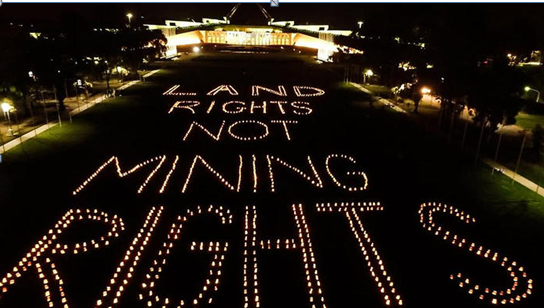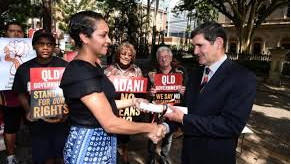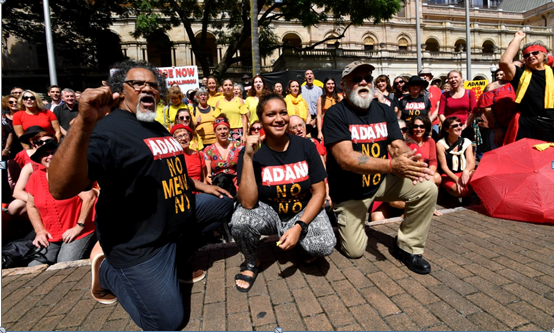The UN intervention marks yet another milestone in the legal and public fight of the Wangan and Jagalingou traditional owners to secure their ancestral lands.
Australia’s biggest coal ambition
The W&J registered their land claim half a decade before the Australian government got serious about its ambition to open up the Galilee Basin, the continent’s largest reservoir of coal. Roughly 400 kilometres inland from the Great Barrier Reef, the region covers an area as large as the United Kingdom, and holds thrice as much coal as has ever been mined in Australia. The International Energy Agency offers some perspective on the scale of the Galilee’s coal deposit: if all of the Basin’s coal were to be loaded onto a single train, it would stretch to a length of 2.5 million kilometres, or six and a half times the distance to the moon.
Although the first exploration licence to mine the Galilee was taken out in 1970s by Australian mining magnate Lang Hancock, plans to ‘develop’ the Galilee Basin did not eventuate before the 21st century, owing to both to the region’s remoteness and the need for higher prices and demand for thermal coal. Australia’s recent resource boom, the biggest since the gold rush of the mid-1800s, began around 2003 when prices for coal and iron ore, Australia’s two biggest mining exports, started to rise.
Adani embarked on its ambitious Australian mission when the resource boom was at its peak in 2010. Initially estimated to start operations in 2014 and reach full capacity by 2022 to export 60 million tonnes of coal, the Adani mine would be the largest of six megamines, and a total of nine proposed coalmines in the Galilee. The original list of proponents also included the Indian mining company GVK in a joint partnership with an Australian resource giant, Hancock Prospecting.
The scale of Adani’s Carmichael proposal promised to put Australia in the same league as the Powder River Basin coalmines in the United States that have an export capacity of up to 100 million tonnes of coal a year. The Basin constituted one of the four “pillars” for Queensland’s growth as envisioned by the state Liberal National Government under Campbell Newman, with an estimated A$60 billion in revenue generation and the creation of 15,000 jobs. Being ‘in the business of coal’, the Newman government subsidised the Galilee megamines through the Galilee Basin Development Strategy.
Subsequent Queensland governments also meted out special treatment to the Galilee Basin, and particularly to the Carmichael project, the biggest and the first scheduled to begin. The Labor government that followed Premiere Newman’s Liberal government declared the Adani Carmichael project ‘critical infrastructure’, a status that had never before been granted to a private commercial development, on grounds of its perceived economic benefits, allowing the Coordinator General to reduce red tape and sign off on the various ‘conditional approvals’ for the Carmichael project quickly.
Adani and Queensland vs the W&J
The W&J first appealed to the UN Special Rapporteur on the rights of indigenous peoples in October 2015, submitting about Australia’s failure to protect their rights:
“Our ancestral homelands in central‐western Queensland, Australia, are threatened with devastation by the proposed development by a private company, Adani Mining, of the massive Carmichael Coal Mine. … We exist as people of our land and waters, and all things on and in them – plants and animals – have special meaning to us and tell us who we are. Our land and waters are our culture and our identity. If they are destroyed, we will become nothing…We have not consented to the development of the Carmichael mine or any other proposed mine on our traditional lands.”
Australian media has reported a rift within the core council of W&J family representatives who claimed native title over the lands designated for Adani’s mine, with one part of the family council dead set against the mine, and the other side wishing for a better outcome than had been offered from the ILUA [Indigenous Land Use Agreements] negotiations with Adani. However, a key bone of contention for the Wangan and Jagalingou claim group, one shared by all core members, relates to the Carmichael project’s perceived benefits.
Adrian Burragubba, the head of the W&J family council that has sustained a long legal fight against Adani is reported to have first heard of Adani’s exaggerated jobs claims from a high-level company official during a meeting with traditional owners in August 2014. This information came just months before an important meeting between the family members and the company to authorise a land use agreement.
Adani needed an ILUA to undertake all works associated with the project, and secure a 2,750-hectare area for critical infrastructure related to various mining operations including an airstrip, workers’ village, and a washing plant. The Native Title Act, 1993 allows for an agreement between indigenous groups and a mining corporation to be drawn up in six months, failing which the company can approach the Native Title Tribunal to facilitate an ILUA and override objections from traditional owners. The law also allows the state to extinguish Native Title and compulsorily acquire mining land; however, Australian governments have so far avoided such a clear disregard for the wishes of the traditional owners.
The W&J family council refused to grant Adani an ILUA, and the company approached the Native Title Tribunal in April 2015. The company’s 10,000 jobs promise had attracted controversy by this time following the testimony of its own expert in the Queensland Land Court that the forecast was closer to 1464 jobs.
The Tribunal, however, ruled in favour of Adani, finding the project in the public interest on account of Adani Australia’s advertised 10,000 jobs figure that both state and federal governments had accepted. The W&J maintained that Adani had misled the Tribunal with false economic benefit claims from Carmichael. The Tribunal authorised Queensland to issue mining licences and the W&J moved to the federal court for a judicial review of the case of mining licences without an ILUA. The Federal Court also dismissed the W&J case. At the third stage of legal appeal from the W&J, the state’s Supreme Court of Queensland also struck down the case.
Outside the courtroom, the W&J emphasised that they had struck down Adani’s proposed ILUA on three separate occasions during bona fide meetings of the claim group. After the W&J family council first formally rejected Adani’s ILUA in March 2015, they took a Defence of Country Declaration which stated their rights as indigenous people under the UNDRIP [United Nations Declaration on the Rights of Indigenous Peoples] to the Queensland Parliament.
Adrian Burragubba’s ‘Adani, No means No’ slogan grew to become the headline for a sustained indigenous land rights movement to stop Australia’s largest coalmine. Not only were the W&J opponents opposed to coalmining on their ancestral lands, they were concerned about the nature and the adequacy of the benefits, particularly jobs that the company had proposed. A W&J commissioned economic assessment of the ILUA found the proposed compensations to be less than half the industry average. The land use agreement had pegged three quarters of the economic benefits on jobs, raising concerns about its viability in the future given the negative outlook for coal.
At the heart of their ‘No’ lies an understanding of their fundamental right to reject developments that would devastate their legacy, and endanger the future, essentially of free and prior informed consent as they choose to exercise it. Burragubba’s assertion exposes the limitation of Australia’s Native Title Act that does not give indigenous groups the provision to altogether veto mining.

Australia’s Indigenous Youth Climate Network sends a message to federal parliament in May 2017. Image courtesy: Seed Indigenous Youth Climate Network
The W&J pulled out all stops to prevent coalmining on their ancestral lands. The two faces of the campaign, Burragubba and his niece Murrawah Johnson went on a world tour with environmental activists in 2015 to appeal to global investors against the Carmichael project. Eleven international banks including HSBC and Barclays committed to not fund Australia’s largest proposed mine on grounds of standing up for indigenous rights, repeated delays in starting the project, and the effects on the Great Barrier Reef.
Most large banks are signatories to a set of standards commonly known as the Equator Principles that rule out the financing of projects that can harm world heritage sites. The London-based Standard Chartered ended its association with Carmichael, reportedly to avoid reputational damage that the distancing of other global banks from the project had exposed it to.
In a video on the campaign website adaninomeansno.com, Murrawah Johnson talks about the “tremendous task that it is in Australia and Queensland to take on a mining corporation when the laws are stacked against us”. Juggling college assignments and an international advocacy tour in 2015, she had a firsthand chance to experience the scale of devastation of ancestral lands by large fossil-fuel projects when she visited First Nations people in Canada fighting the Keystone Pipeline.
The W&J resistance to the Adani coalmine established itself as part of a global indigenous solidarity against fossil-fuel mining on First Nations people’s land, linking with major indigenous protests in Canada to the Keystone Pipeline and in the United States to the Dakota Access Pipeline. At a Brisbane symposium in July 2018, the global alliance called for rethinking development so that ‘indigenous people’s rights and the realities of a climate constrained world’ are both kept at the centre.
In the meantime, a significant opportunity to reject Adani’s ILUA arose for the W&J after a High Court ruling in February 2017 from Western Australia interpreted the Native Title Act to mean that any ILUA drawn up without the consent of all registered native title claimants from an indigenous community is invalid. The Australian prime minister is reported to have delivered assurances of ‘fixing native title uncertainty’ to the Adani Group in person during a state visit to New Delhi in April.
Less than two weeks after the McGlade decision, the federal government introduced legislation to annul the effects of the High Court ruling, and it finally passed through both houses with the support from the Labor opposition in August. It was widely held that the government’s move on Native Title was to help clear the way for the Carmichael project.

Murrawah Johnson presents a Declaration of Defence of Country to Queensland’ speaker of the house in 2015. Photo courtesy: Dan Peled/AAPImage
‘Disproportionate’ cost of resistance
The W&J’s legal track of work against the Carmichael mine continued side by side with its international public campaign. After three unfavourable decisions from various courts, the W&J lodged a case in the Federal Court in December 2016 around how Adani ‘conducted’ a crucial meeting in April where traditional owners voted for an ILUA for Adani. The W&J native title claim group is made up of 12 W&J families. Seven of these families are reported to have voted for an Adani ILUA.
The W&J federal case alleged that Adani provided generous travel and accommodation for attendees who voted favourably, that the company ‘stacked’ the meetings with non W&J native title claimants who had never attended a single meeting before. Various allegations of bribery included claims that the company collectively paid more than A$10,000 to the seven pro-Adani family members.
Adani spokespersons refuted these allegations, and maintained that due process had been followed in the meeting where traditional owners had “overwhelmingly” voted for the Carmichael mine. Adani’s ILUA success was however short-lived since by June one of the seven pro-W&J family representatives withdrew his support.
The allegedly ‘sham’ ILUA case continued till mid-2018, and the final decision yet again ruled against the W&J. It raised the prospect of the state stepping in to wipe out the W&J’s native title over and hand over property rights to Adani. The W&J wrote to the state government asking not to risk extinguishing their rights over ancestral lands for a project whose prospects of going ahead were weak.
It has been reported that following internal pressure from within the Labor party that is currently in power in Queensland, the state government decided to hold off on extinguishing the W&J’s native title rights at the mine site till the company could prove its finances were in place. The Queensland government acknowledged that the ILUA was “contested amongst traditional owners”.
Next, the W&J moved for a Federal Court full bench appeal of the decision. By this time, Adani Australia’s lawyers had tallied up cost orders against the W&J from previous Supreme and Federal Court proceedings at A$870,000. The company asked the court to direct W&J to pay A$160,000 in security money within a fortnight, failing which the “appeal be dismissed with costs”. In a hearing last December, the court found Adani’s estimate “disproportionate”, and revised the W&J’s security money to A$50,000.
The W&J’s legal and public campaigns have mostly been crowd-funded and assisted by lawyers on a pro-bono basis. Many of the 100,000 supporters on their campaign list, and the 12,000 followers on Facebook have personally donated to the fight. The ‘Adani no means no’ campaign was able to salvage its legal fight within the stipulated 14 days through a public interest litigation group Grata Fund’s donations. This appeal is now due for hearing in May.
For the W&J, a hectic pace in and out of the courts has become the new normal. As Adani announced in late November that it will finally begin operations, a small group of traditional owners travelled to Korea to dissuade major financial institutions not to lend to the controversial project. Adani had reportedly been in talks with establishments in Seoul. The W&J received written commitments from Korean banks to not fund the Carmichael project. And then in the new year, the United Nations wrote to the Australian government expressing its concerns about the rights of the W&J.
Unprecedented resistance
The W&J’s resistance to surrendering their lands evokes other such historic indigenous environmental struggles in Australia, most prominently, the resistance to the Jabiluka uranium mine on the land of the Mirrar people in the Northern Territory in the nineties and the resistance to a coastal gas hub on the Kimberley coast in Australia’s northwest, the traditional lands of the Goolarabaloo people six years ago.
But their global reach, set against the broader context of Australia’s economic dependency on coal and international movements on climate change, make the relevance of their struggle more complex, and its stake perhaps more widely shared.
Even though the Carmichael project has now significantly reduced in scale from its original proposed capacity, it still holds the key to the rest of the Galilee Basin’s projects. On several occasions during the last five years, the repeated W&J legal challenges stood as the only legal hurdles in the path of the mine commencing operations, with most other environmental challenges having been ruled unfavourably by courts.
Their long legal battle severely exposed the limitations of Australia’s Native Title Act to protect the historic and cultural interests of indigenous communities. The rushed amendments to the Act in response to the McGlade decision, passed through Parliament amidst criticism from indigenous communities betrayed a certain desperation of the part of the Australian government to open up its last coal frontier.
The W&J’s international campaign coincided with critical and significant movements in North America against fossil fuel mining on indigenous lands at a time when the world was moving towards a global climate consensus in Paris. The concurrence of these struggles against massive coal, oil and gas projects made the human rights aspect of climate resistances starkly obvious. The fight against the Carmichael mine has been the largest Australia has seen in recent times. And the indigenous land struggle against Adani, fought by a small group of traditional owners entirely with public donations, has been one of its most tenacious arms.
Ruchira Talukdar is a PhD scholar at the School of Social and Political Sciences, University of Technology Sydney. Her research compares energy politics and environmental mass movements in India and Australia. The material for this article was collected through interviews during research field trips as well as through a variety of news media.
Courtesy: Newsclick.in
